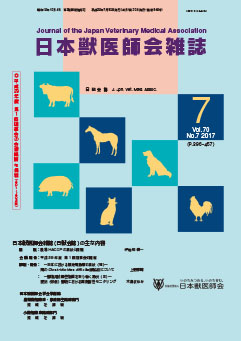
- |<
- <
- 1
- >
- >|
-
Kenichiro KOBAYASHI, Akira KANDA, Chie KOBAYASHIArticle type: Short Communication
2017 Volume 70 Issue 7 Pages 435-437
Published: July 20, 2017
Released on J-STAGE: August 20, 2017
JOURNAL FREE ACCESSWe investigated the effect of infection with the Bovine Leukemia Virus (BLV) on productivity and reproduction in dairy cattle. The cattle from one dairy farm were assessed from May to December 2015 in this study. Productivity and reproduction data, which were obtained from the Dairy Herd Performance Test, were compared between the BLV-infected and uninfected cows. Milk yield and milk quality did not differ between BLV-infected (n=160) and uninfected (n=176) cows (P>0.05). The open period did not differ between BLV-infected (n=14) and uninfected (n=18) cows (P>0.05). There were no differences between the BLV-infected and uninfected cows. Enzootic Bovine Leukosis (EBL) occurred on the farm during the period of the survey. It is important to reduce the rate of BLV-infected cows to prevent EBL on a dairy farm.
View full abstractDownload PDF (621K) -
Jiro IWAMOTO, Shoichiro FUJIZONOArticle type: Short Communication
2017 Volume 70 Issue 7 Pages 438-441
Published: July 20, 2017
Released on J-STAGE: August 20, 2017
JOURNAL FREE ACCESSTo investigate the effectiveness of commercialized porcine epidemic diarrhea (PED) vaccine, epidemiological data from PED-affected pig farms in Kagoshima Prefecture were analyzed. In a comparison of unvaccinated and properly vaccinated groups, two inoculations of PED vaccine before farrowing reduced the morbidity rate and relative risk of sows and piglets, suggesting the effectiveness of proper vaccination. There were no major differences in the morbidity rate and relative risk of sows between the improperly vaccinated group, such as only one inoculation of PED vaccine before farrowing, and the unvaccinated group. Although the morbidity rate and relative risk of piglets in the improperly vaccinated group were lower than those in the unvaccinated group, it appeared that improper vaccination conferred insufficient protection. The fatality rate and relative risk of piglets did not differ between all the groups, suggesting that the deaths of piglets that developed clinical signs of PED were not prevented by the PED vaccine, although it is possible for the vaccine to suppress the development of PED in piglets. Accordingly, to prevent the loss of piglets, it is essential to decrease the rate of infection of piglets by improving biosecurity at the farms and prevent PED development with proper vaccination.
View full abstractDownload PDF (665K)
-
Shotaro ETO, Kenji TANI, Harumichi ITOH, Masato HIYAMA, Shinpei NISHIK ...Article type: Short Communication
2017 Volume 70 Issue 7 Pages 443-447
Published: July 20, 2017
Released on J-STAGE: August 20, 2017
JOURNAL FREE ACCESSA 12-year-old spayed female Miniature Dachshund that presented with urethral transitional cell carcinoma (TCC) underwent surgery to remove the tumor. The entire urethra and cranial portion of the vagina were resected. The consequent defect of the urinary tract was reconstructed using the bladder body. The bladder body was transferred to the vagina stump by rotation of the bladder apex through the ventral side. After a Foley catheter was inserted into the rotated bladder through the vagina and the incised hole of the bladder apex, the bladder was anastomosed to the vagina. The case was able to urinate involuntarily through the vulva immediately after the operation. Swelling of the sublumber lymph node was found by X-ray CT on the 126th day of the illness and lymph node metastasis was suspected. The QOL of the case had been improved and maintained, however. There were few reports about the urethral complete removal and the bladder-vagina anastomosis for TCC and furthermore no reports about anastomosis between the rotated bladder and the vagina. This operation was unable to preserve the function of the bladder, but will help in the treatment of urethral TCC of female dogs.
View full abstractDownload PDF (933K)
- |<
- <
- 1
- >
- >|